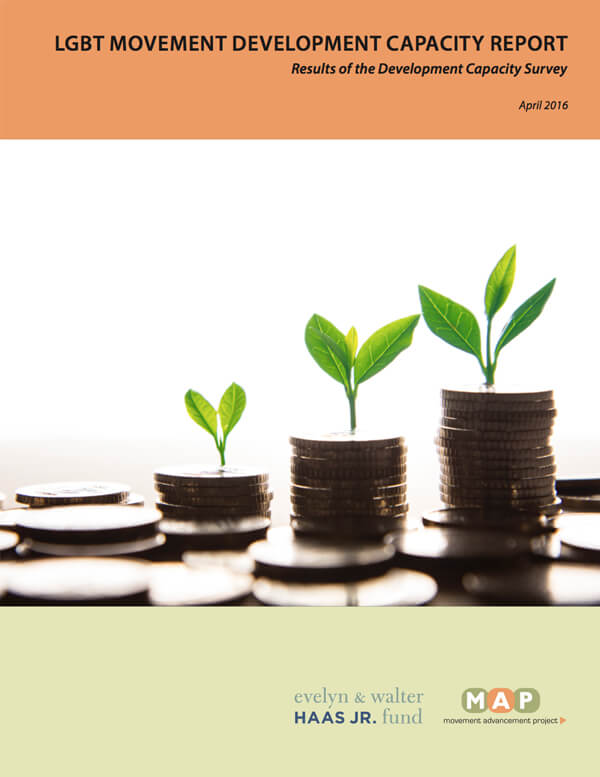The Bottom Line
The National LGBT Movement Report, published annually by MAP, examines revenue and expenses, fundraising and fundraising efficiency, and other indicators of financial health for lesbian, gay, bisexual and transgender (LGBT) social justice advocacy, issue, legal, research and public education organizations.
2016 National LGBT Movement ReportDownload 2015 National LGBT Movement ReportDownload 2014 National LGBT Movement ReportDownload 2013 National LGBT Movement ReportDownload 2012 National LGBT Movement ReportDownload 2011 National LGBT Movement ReportDownload 2010 National LGBT Movement ReportDownload
Abstract
The 2016 National LGBT Movement Report provides a comprehensive snapshot of the financial health of LGBT social justice organizations. The 36 organizations examined in this year's report collectively represent 45% of the budgets of all LGBT social justice advocacy organizations. Among the key findings in the 2016 report:
Revenue and Expenses
- Participating organizations reported an 8% increase in revenue for 2015 over 2014. In comparison, the top 100 nonprofit organizations nationwide reported a combined growth of just 2.6%. Expenses for participating organizations also increased 4% from 2014.
- Individual donor and corporate contributions continue to grow. Individual donor revenue, the greatest share of cumulative revenue, grew 5% from 2014 to 2015. Organizations raised a combined total of $6.8 million from corporate contributions in 2014 and $9.6 million in 2015, a 41% increase. Notably, among the 33 organizations reporting this data, the number of donors giving $25,000 or more increased by 45% over five years.
- Participating organizations have robust working capital and have kept fundraising costs low. Of total expenses, 79% were dedicated to programs and services and only 11% to fundraising, well above nonprofit standards.
- The indicators of financial health show a movement poised for the work ahead in the near future. The average liquidity ratio is healthy, and long-term debt is down for participating organizations, however, so are long-term assets.
Staff and Boards
- Organizations have diverse staff that mirror the overall population. 38% of paid staff at participating organizations identify as people of color. Among senior staff, 36% identify as people of color.
- Slightly less than half of staff (48%) identify as women, 46% as men, and 6% as genderqueer or another gender. Slightly more than one in ten staff (11%) identify as transgender. Of the 31 non-transgender-specific organizations that reported this data, 11 have more than 10% of their staff who identify as transgender.
- For the first time this year, participating organizations were asked to report on the sexual orientation of their staff and board members. Of the 24 participating organizations to report this data, 59% of staff identified as gay or lesbian, 7% as bisexual, 0.2% as asexual, 24% as another orientation, and 10% as straight.
The report also uncovered some challenges ahead:
- While there has been a cumulative increase in revenue from individual contributions, LGBT organizations continue to rely on contributions from a small fraction of the LGBT community. The total number of people who gave $35 or more to a participating organization represents approximately 3.1% of the total number of LGBT adults in the United States.
- For the 33 organizations reporting this data, donors giving $35 to $999 decreased 7% from 2014 to 2015, while donors giving $1,000 to $24,999 increased 2% and donors giving $25,000 or more increased 6%. Compared to 2011, the number of donors increased across all categories. Most notably, the number of donors giving $25,000 or more increased by 45% over five years.
- A few organizations experienced steep revenue decline despite steady growth overall for participating organizations. Fourteen organizations experienced revenue declines, with an average decline of 20% for these organizations. Participating organizations also experienced an aggregate 11% decrease in government funding, which comprised just 2% of total revenue in 2015. This number is likely to decline further given the shift in administration.
2016 Participating Organizations
ACLU LGBT & AIDS ProjectBasic Rights OregonCenterLinkEquality CaliforniaEquality FederationEquality FloridaEquality MaineFamily Equality CouncilFunders for LGBTQ IssuesGay & Lesbian Advocates & Defenders (GLAD)Gay & Lesbian Victory Fund
and Leadership InstituteGLSENGay-Straight Alliance NetworkGLAADHuman Rights Campaign and Foundation (HRC)Immigration EqualityKeshetLambda Legal DefenseLog Cabin Republicans & Liberty
Education ForumMassEqualityNational Center for Lesbian Rights (NCLR)National Center for Transgender Equality (NCTE)National Queer Asian Pacific Islander Alliance (NQAPIA)New York City Gay and Lesbian Anti-Violence ProjectOut & Equal Workplace AdvocatesPFLAG NationalPoint FoundationReconciling Ministries NetworkServices & Advocacy for GLBT Elders (SAGE)SoulforceSylvia Rivera Law ProjectThe National LGBTQ Task ForceTransgender Law CenterThe Trevor ProjectTrue Colors United(One organization preferred not to be listed.)


